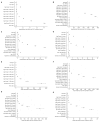Risk factors for severe COVID-19 outcomes in LATAM countries in the post-vaccination era: an analysis of national surveillance data in Argentina, Brazil, Colombia, and Mexico
- PMID: 40292722
- PMCID: PMC12035972
- DOI: 10.7189/jogh.15.04141
Risk factors for severe COVID-19 outcomes in LATAM countries in the post-vaccination era: an analysis of national surveillance data in Argentina, Brazil, Colombia, and Mexico
Abstract
Background: Identifying cases at higher risk for severe COVID-19 outcomes is essential for tailoring interventions for prevention and treatment. We aimed to determine the factors related to hospitalisation, intensive care unit (ICU) admission, use of ventilatory support, and mortality in four Latin American countries.
Methods: We conducted a retrospective study using national COVID-19 surveillance databases from Argentina, Brazil, Colombia, and Mexico, covering the period from January 2021 to December 2022. We used multivariate logistic regression models to identify factors associated with hospitalisation, ICU admission, ventilatory support, and death, adjusting for confounding variables.
Results: We included 34 955 384 confirmed cases in the analysis. Age and sex were significantly associated with increased odds of all outcomes. For hospitalisation, in cases aged >85 years, the odds ratio (OR) for hospitalisation ranged from 26.46 (95% confidence interval (CI) = 25.67-27.28) in Mexico to 2763.87 (95% CI = 2644.40-2888.73) in Brazil, and for males, it ranged from 1.42 (95% CI = 1.41-1.43) in Colombia to 1.77 (95% CI = 1.76-1.78) in Brazil. Indigenous race was significantly associated with higher odds of hospitalisation (ORs ranging from 1.26 to 1.98) and death (ORs ranging from 1.05 to 1.84). The number of comorbidities reported was related to increased odds of severe outcomes and varied across countries. The odds of death for cases with zero vaccine doses were significantly higher (ORs ranging from 1.72 to 31.73) compared to cases with two doses. Similarly, the odds of death for cases with one dose were significantly higher (ORs ranging from 1.73 to 7.00) compared to cases with two doses.
Conclusions: Even in a post-vaccine implementation scenario, individual factors such as age, gender, comorbidities, and race still pose a risk to severe COVID-19, which demands tailoring public health strategies for prevention and treatment.
Copyright © 2025 by the Journal of Global Health. All rights reserved.
Conflict of interest statement
Disclosure of interest: The authors completed the ICMJE Disclosure of Interest Form (available upon request from the corresponding author) and disclose the following activities and relationships: drafting support for the preparation of this manuscript was provided by IQVIA and funded by Pfizer. MHK, GSJ and MHK are employees of Pfizer. The other authors do not report other relevant affiliations or financial involvement with any organisation or entity with an interest or conflict with the subject matter or materials discussed in the manuscript in addition to those disclosed.
Figures



Similar articles
-
Severe COVID-19 Outcomes in Five Latin American Countries in the Postvaccination Era.Viruses. 2024 Jun 26;16(7):1025. doi: 10.3390/v16071025. Viruses. 2024. PMID: 39066188 Free PMC article.
-
Risk factors for disease progression and clinical outcomes in patients with COVID-19 in Taiwan: a nationwide population-based cohort study.BMC Pulm Med. 2025 Jan 26;25(1):43. doi: 10.1186/s12890-024-03468-x. BMC Pulm Med. 2025. PMID: 39865259 Free PMC article.
-
Obesity in patients with COVID-19: a systematic review and meta-analysis.Metabolism. 2020 Dec;113:154378. doi: 10.1016/j.metabol.2020.154378. Epub 2020 Sep 28. Metabolism. 2020. PMID: 33002478 Free PMC article.
-
Socioeconomic factors and COVID-19 mortality in immune-mediated rheumatic diseases patients: regional analysis from Argentina, Mexico and Brazil.Adv Rheumatol. 2024 Oct 9;64(1):78. doi: 10.1186/s42358-024-00418-3. Adv Rheumatol. 2024. PMID: 39385233
-
The burden of osteoporosis in four Latin American countries: Brazil, Mexico, Colombia, and Argentina.J Med Econ. 2019 Jul;22(7):638-644. doi: 10.1080/13696998.2019.1590843. Epub 2019 Mar 25. J Med Econ. 2019. PMID: 30835577 Review.
Cited by
-
Immune response to and virological profile of SARS-CoV-2 before and after symptom onset in individuals vaccinated with inactivated COVID-19 vaccines.Hum Vaccin Immunother. 2025 Dec;21(1):2518654. doi: 10.1080/21645515.2025.2518654. Epub 2025 Jun 18. Hum Vaccin Immunother. 2025. PMID: 40530661 Free PMC article.
References
-
- Song R, Xu J, Cao B.COVID-19 Pandemic: End of emergency, but not end of challenge. Inn Med. 2023;1:100004.
-
- United Nations Economic Commission for Latin America and the Caribbean. The sociodemographic impacts of the COVID-19 pandemic in Latin America and the Caribbean. Santiago, Chile: United Nations Economic Commission for Latin America and the Caribbean; 2022. Available: https://www.cepal.org/en/publications/47923-sociodemographic-impacts-cov.... Accessed: 31 March 2025.
-
- Pan American Health Organization. SARS CoV2 Situation - Region of the Americas. 2024. Available: https://www.paho.org/en/covid-19-weekly-updates-region-americas. Accessed: 1 September 2024.
MeSH terms
Substances
LinkOut - more resources
Full Text Sources
Medical
